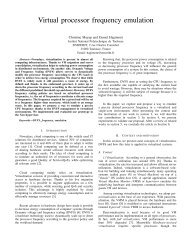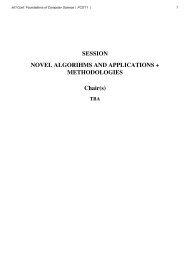SESSION GRAPH BASED AND TREE METHODS + RELATED ...
SESSION GRAPH BASED AND TREE METHODS + RELATED ...
SESSION GRAPH BASED AND TREE METHODS + RELATED ...
- TAGS
- graph
- methods
- world-comp.org
You also want an ePaper? Increase the reach of your titles
YUMPU automatically turns print PDFs into web optimized ePapers that Google loves.
16 Int'l Conf. Foundations of Computer Science | FCS'12 |<br />
On the Optimality of a Family of Binary Trees<br />
Dana Vrajitoru<br />
Computer and Information Sciences Department<br />
Indiana University South Bend<br />
South Bend, IN 46645<br />
Email: danav@cs.iusb.edu<br />
Abstract—In this paper we present an analysis of the complexity<br />
of a class of algorithms. These algorithms recursively explore<br />
a binary tree and need to make two recursive calls for one of the<br />
subtrees and only one for the other. We derive the complexity of<br />
these algorithms in the worst and in the best case and show the<br />
tree structures for which these cases happen.<br />
I. INTRODUCTION<br />
Let us consider a traversal function for an arbitrary binary<br />
tree. Most of these functions are recursive, although an iterative<br />
version is not too difficult to implement with the use of a<br />
stack [1]. The object of this paper, though, is those functions<br />
that are recursive.<br />
For the remainder of the paper we’ll consider the classic<br />
C++ implementation of a tree node as follows:<br />
template <br />
struct node {<br />
otype datum;<br />
node *left, *right;<br />
};<br />
When a recursive function makes a simple traversal of a<br />
binary tree with n nodes, in which the body of the traversal<br />
function contains exactly two recursive calls, one on the left<br />
subtree and one on the right, and all other parts of each<br />
call require Θ(1) time, then the execution time is roughly<br />
proportional to the total number of calls (initial and recursive)<br />
that are made. In this case that will be 1 + 2n (the call on<br />
the pointer to the root of the tree and one call on each of the<br />
2n pointers in the tree), so the execution time is Θ(n). The<br />
analysis would apply, for example, to the function below that<br />
traverses the tree to calculate its height [2].<br />
int height (node_ptr p) {<br />
if (p == NULL)<br />
return -1;<br />
int left_height = height (p->left);<br />
int right_height = height (p->right);<br />
if (left_height left) right))<br />
return 1 + height(p->right);<br />
else<br />
return 1 + height(p->left);<br />
}<br />
At first sight it would seem that this is not a very useful<br />
problem to study because we can easily correct the fact that<br />
this function performs two recursive calls on one of the<br />
subtrees. We can store the result of the function in a local<br />
variable and use it instead of the second recursive call, as<br />
implemented in the first version of the function. Even if this is<br />
the case indeed, it would still be useful to know just “how bad”<br />
the complexity of the function can get from a simple change.<br />
Although the problem might sound simple, the complexity<br />
calculation requires a careful analysis of the tree structure and<br />
reveals interesting tree properties related to the height of the<br />
larger subtree.<br />
The second motivation is that just as the function height<br />
is representative of a whole class of traversal functions for<br />
binary trees, the analysis for the function height1 can also<br />
be applied to a whole class of functions. Some of these can<br />
be optimized with the method used for the function height,<br />
but some of them might require operations making the second<br />
recursive call on the same subtree necessary.<br />
An example of such a problem would be modifying the<br />
datum in each of the nodes situated in the taller subtree of<br />
any node. One traversal is necessary to determine the height<br />
of the subtrees. A second traversal is necessary for the subtree<br />
of larger height to increment its datum values.<br />
The trees that we are studying here are somewhat related to<br />
increasing trees that are also related to recursion [3]. Theorems<br />
providing limits to sum of weights and the path length of such<br />
trees can be found [4]. The problem is also related to binary<br />
trees with choosable edge length and cryptography [5].<br />
The idea of balancing the weights in a tree to optimize a<br />
particular function is of a more general nature and is also









